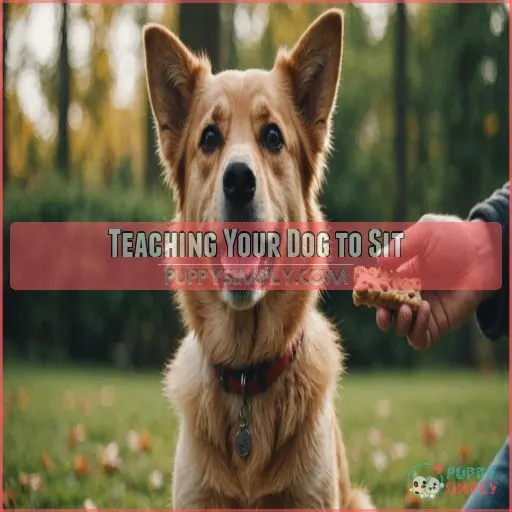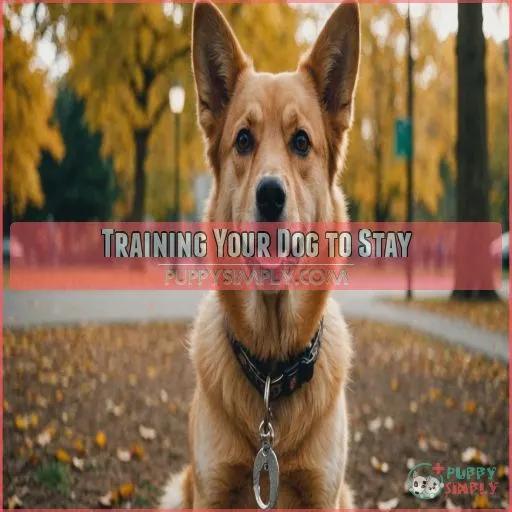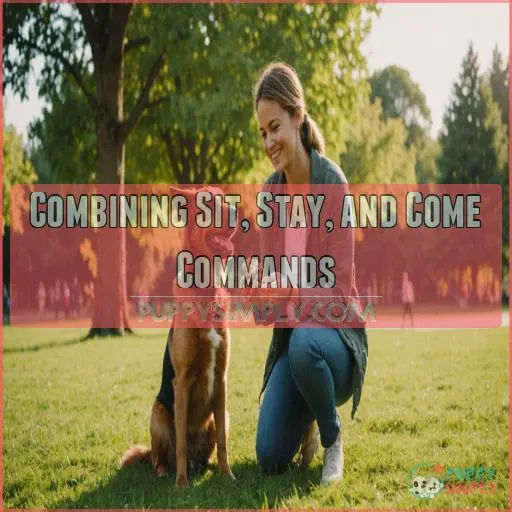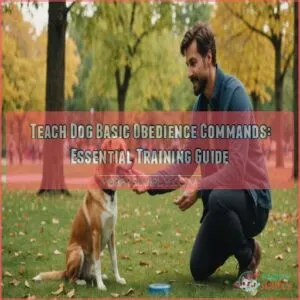This site is supported by our readers. We may earn a commission, at no cost to you, if you purchase through links.
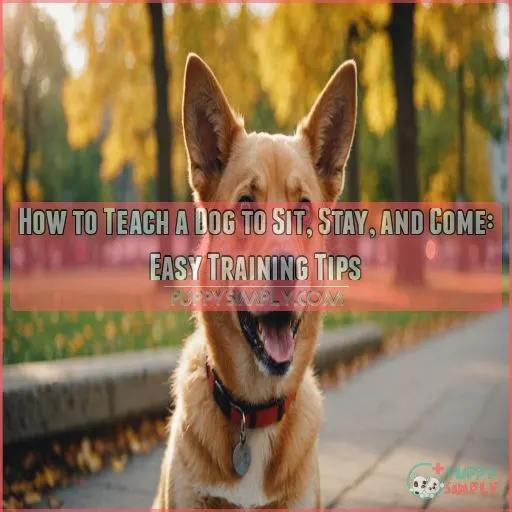
First, grab some tasty treats—little bribes never hurt anyone.
To teach "sit", hold the treat over their nose until their bottom hits the floor, then praise them like they’ve just won the lottery.
For "stay", ask them to sit, then step back, gradually increasing your distance. Keep the encouragement rolling sweet and steady.
The "come" command works wonders when practiced with praise as your pooch returns.
Patience is key, and with a sprinkle of humor, you’ll both be wagging in harmony, ready to learn what’s next!
Table Of Contents
- Key Takeaways
- Preparing Your Dog for Training
- Teaching Your Dog to Sit
- Training Your Dog to Stay
- Mastering the Come Command
- Combining Sit, Stay, and Come Commands
- Overcoming Common Training Challenges
- Frequently Asked Questions (FAQs)
- How to train your dog to sit, stay, and come?
- How long does it take to train a dog to sit and stay?
- Why won’t my dog sit and stay?
- How to train your dog to come?
- How long does it take for a dog to learn the sit, stay, and come commands?
- What are the best treats to use for training a dog?
- Can I train my dog to sit, stay, and come without using treats?
- How do I know if my dog is ready to move on to more advanced commands?
- What should I do if my dog refuses to obey the sit, stay, or come commands?
- Conclusion
Key Takeaways
- Use treats wisely: Think of them as little bribes. Hold a treat over your dog’s nose for "sit," and praise them like they’ve just discovered a new breed of flavor. For "come," make the reward immediate and exciting, like ushering them to the best show in town.
- Create the perfect training space: Imagine setting up a VIP lounge. Choose a cozy spot free from distractions, where your pup can focus better than a cat on a laser pointer. Stick to a routine and be consistent with your encouragement.
- Go the extra mile with positive reinforcement: Dogs respond to training when it’s a rewarding experience. Think of yourself as their personal cheerleader—celebrate victories with treats, praise, or playtime. Be consistent and your pup will be a sit-stay-come pro in no time.
- Practice in various locations: Dogs are like teenagers—they love to test boundaries. Once they’ve mastered the commands at home, take the show on the road! Try the garden, dog parks, or even amid the hustle of new neighborhoods. This builds their confidence to perform under any spotlight.
Preparing Your Dog for Training
Before you can teach your pup to sit, stay, and come, you’ll need to set them up for success.
Start by choosing the right rewards and creating a positive training environment that fits your dog’s unique learning style.
Choosing the Right Rewards and Treats
Finding the perfect treat is like choosing the right dance partner—it makes all the difference!
For dog training, use a mix of dog food as rewards, homemade dog treats, or choose ones suited for specific breeds.
Watch for allergies and make praise a priority.
A release word signals success using positive reinforcement, ensuring your furry friend relishes commands at any age.
Creating a Training Environment
After picking the right treats, let’s create a distraction-free zone for training! A quiet space makes sure your pup stays focused. Here’s how:
- Safe and Comfortable: Choose a cozy spot where your dog can relax.
- Consistent Routine: Stick to regular training sessions.
- Positive Reinforcement: Use rewards to encourage obedience.
You’ll see their behavior improve in bounds!
Understanding Your Dog’s Learning Style
Understanding your dog’s learning style is a bit like cracking a secret code. Each dog is unique, with distinct behavior cues.
| Dog Type | Learning Style | Motivation |
|---|---|---|
| Adventurous | Quick to explore | Toys, new places |
| Sensitive | Cautious, gentle | Calm praise, treats |
| Confident | Bold, independent | Variety, challenges |
| Shy | Hesitant, reserved | Patience, calmness |
| Energetic | Zesty, playful | Games, physical play |
Embrace their quirks and incorporate positive reinforcement and consistency. Think like a detective in dog training, spotting those motivation techniques!
Setting Realistic Training Goals
Before you start training, it’s important to set realistic goals for your pup.
Consider their age, breed, and your available time.
Puppies have short attention spans, so aim for frequent, 5-10 minute sessions.
With patience and consistency, you’ll both master the sit, stay, and come commands.
Remember, every dog learns differently, so adjust your approach as needed.
Teaching Your Dog to Sit
Teaching your dog to sit is a fundamental skill that can make daily life easier, like when you’re juggling grocery bags and they need to stay put.
With the right treats and a touch of patience, your pup will be sitting like a furry pro in no time!
Using Positive Reinforcement Techniques
Ready to teach your dog to sit? Positive reinforcement is your golden ticket! Dogs respond best when learning is fun and rewarding. Here’s the recipe for success with an engaging twist:
- Treats: A little bribery goes a long way!
- Timing: Catch ’em in the act.
- Consistency: Steady wins the race.
- Rewards: Celebrate the victories.
- Motivation: Keep it high!
Holding Treats and Toys to Encourage Sitting
When teaching "sit," timing is everything.
With treat placement, hold the treat just above your dog’s nose.
Like magic, they’ll follow it down, bottom to the floor.
Toy motivation works, too!
Hand signals paired with timing cues make it clear.
Reward timing? Spot on as they sit.
Remember, patience and practice lead to a well-mannered pup.
Gradually Phasing Out Treats and Praise
Once your pup has the sit command down, you can gradually phase out the treats and praise.
Instead, use a simple "good job" or a quick pet as a reward.
This helps reinforce the behavior without over-relying on food.
Stay consistent with your timing and be patient – your dog will soon sit on command without needing constant rewards.
Practicing Sitting in Different Locations
You know dogs, they’re like teenagers—easily distracted and love testing boundaries.
Practice sit in various locations to keep them sharp:
- Indoor vs. Outdoor: Try places like the kitchen or garden.
- High Traffic: Amidst bustling areas.
- New Environments: Parks or new neighborhoods.
- Varying Surfaces: Grass, carpet, or sand.
Mix it up!
Training Your Dog to Stay
Once your dog has nailed the sit command, it’s time to teach them to stay—a bit like the canine version of "freeze tag."
With some patience and the right techniques, you’ll have them planted like a statue, even if the neighbor’s cat prances by.
Building on the Sit Command
Now that your dog can sit like a pro, it’s time to add flair. Consider Sit-Stay Moves like balancing a tightrope—steady, focused, and ready for adventure! As you work on Stay Duration, gradually add distance.
Manage Distractions While Staying by practicing in various spots. Real-World Application means your dog’s ready for the dog park spotlight!
| Practice Tips | Fun Fact |
|---|---|
| Start small | Dogs love to please! |
| Increase distance | Patience beats haste! |
| Vary locations | Dogs can smell rain! |
| Minimize distractions | Treats are the dog’s gold! |
Introducing the Stay Command With Verbal Cues
Next, introduce the "stay" command using clear verbal cues.
Start with a simple "stay" as you hold up your hand.
Reward your pup with praise and a treat when they remain in place.
Be consistent with your timing and cues – this helps reinforce the behavior you want to see.
Gradually Increasing Distance and Time
Once your dog aces the "stay" command with cues, let’s test your pup’s patience by increasing distance and time. Think of it like stretching taffy:
- Start a step away; extend your distance slowly.
- Add five seconds each time.
- Keep consistent sessions.
- Use lots of praise and treats.
Remember, patience pays off!
Overcoming Distractions and Challenges
As you progress with distance, dog park distractions can make "stay" a bit of a circus.
Stay consistent and embrace puppy play dates as teachable moments.
Food motivation is your secret weapon.
Trade chaos for quiet time, letting your pup master staying put.
Remember, Rome wasn’t built in a day—be patient, and soon they’ll be a stay-put rockstar!
Mastering the Come Command
Getting your dog to come when called is like having a magic leash, but without the leash!
With a little patience and some tasty treats, you’ll turn your dog into a recall wizard, ready to impress at the park or from the backyard.
Starting With Short Distances and Gradually Increasing
Start small and gradually increase the distance as your pup masters the come command.
Begin with just a few feet away, rewarding them the instant they reach you.
Slowly build up the distance, keeping training sessions brief and upbeat.
This step-by-step approach helps your dog learn to reliably come when called, even with distractions.
Using Rewards and Praise to Encourage Returning
Imagine your dog returning to you like a superstar on a red carpet, excited for praise and treats!
To make this happen, make sure you use rewards effectively:
- Timing: Offer treats immediately as your dog returns.
- Consistency: Be reliable with your praise.
- Variety: Mix treats and verbal kudos for ultimate motivation.
Your pup will be a comeback champ in no time!
Introducing Verbal Cues and Hand Signals
Getting your dog to respond to verbal cues and hand signals is a bit like teaching them a secret language.
Timing is key.
When introducing "come," pair clear cues with consistent hand signals and a dash of positive reinforcement.
Imagine this: you’re the maestro, orchestrating a symphony of paws!
Here’s how to combine signals:
| Cue | Hand Signal |
|---|---|
| "Come" | Sweeping arm motion |
| "Sit" | Palm up, moving down |
| "Stay" | Open palm stop |
Practicing in Different Environments and Situations
Now you’ve got those verbal cues and hand signals down, it’s time to practice in different environments.
Head to a dog park—it’s like a canine carnival.
Try loud places like noisy streets or during home distractions.
Give it a whirl during car rides or when visitors drop by.
Your dog will ace the come command, rain or shine!
Combining Sit, Stay, and Come Commands
Now that your pup has mastered the individual commands, it’s time to put them all together! Practicing the sit-stay-come sequence will help reinforce your dog’s obedience and build their confidence.
Creating a Training Sequence for Sit-Stay-Come
You’ve nailed "come," and it’s time to craft your dog’s sit-stay-come routine.
Think of it like orchestrating a little dance—each move in perfect order!
Keep sessions upbeat and brief to outwit distractions.
Timing’s key: slow and steady wins the race.
Layer on positive reinforcement, dish out praise like it’s going out of style.
Voilà, you’re building a harmonious canine symphony!
Practicing Transitions Between Commands
Imagine this: Fido pulls off a perfect “sit,” “stay,” and “come” combo. Practice like you’re hosting a doggie Olympics!
- Mix It Up: Use varied order to reward smooth changes, keeping it fun.
- Build Confidence: Praise enthusiastically for mastery.
- Real-World Scenarios: Practicing in diverse settings helps nail sequence timing and sharpen distraction control.
Your pup’s bound to become a pro!
Gradually Increasing Difficulty and Distractions
As your dog’s confidence in changes grows, shake things up by practicing in distracting, real-world environments.
Parks, sidewalks, or nosey backyards are perfect.
Toss in a squirrel or two—but not literally!
The aim is to help your pup master commands amidst everyday chaos, turning challenges into pawsibilities.
With practice, your dog’s focus can become as sharp as a chew toy’s squeak!
Reinforcing Good Behavior and Consistency
Reinforce good behavior by rewarding your pup with treats, praise, and playtime whenever they nail those commands.
Consistency is key – stick to your training plan and reward system, and be patient.
With time and repetition, those sit, stay, and come skills will become second nature.
You’ve got this, champ!
Overcoming Common Training Challenges
Training a dog sometimes feels like trying to dance with a partner who’s hearing a different tune.
Don’t worry—if distractions, anxiety, or off-leash chaos have you tangled up, we’ve got the tips to keep you and your pup in perfect step!
Addressing Distractions and Lack of Focus
Once you’ve combined sit, stay, and come commands, it’s time to tackle dog distractions!
Keep your pup’s focus by practicing in noise-filled areas.
Use a reward system for ignoring distractions.
Think of focus training as yoga for dogs—relax, breathe, and stay consistent.
You’ll soon master the art of controlling chaos with training consistency.
Ready, set, fetch focus!
Managing Separation Anxiety and Fear
Just like squirrels stealing your snacks, distractions are pesky.
Now let’s tackle separation anxiety by reassuring your furry friend.
Spot Signs of Anxiety: pacing, whining, or chewing.
Use Crate Training for a safe haven.
Try Desensitization by leaving for short spurts.
Add Comfort Items like your shirt, and boost Playtime before leaving so they’re happily pooped and snoozing.
Dealing With Off-Leash Challenges and Safety Concerns
Taking your pup off-leash can be tricky, but with the right precautions, your pup can safely explore the great outdoors.
Always keep them on a long leash in high-traffic areas or dog parks to prevent them from darting into danger.
Equip them with a sturdy harness and ID tags for added security.
Stay vigilant and reward their reliable recall – it’ll give you both peace of mind.
Seeking Professional Help and Guidance
Got a pup that’s acting like a monkey in a banana store? Consider consulting certified dog trainers to tackle those pesky behavior issues. Sometimes, professional advice is the missing ingredient in your training stew.
Training classes bring structure and community, helping both you and Rover.
Remember, asking for help isn’t throwing in the towel—it’s grabbing the reins smarter!
Frequently Asked Questions (FAQs)
How to train your dog to sit, stay, and come?
Imagine you’re the maestro of your furry orchestra!
Use treats like applause.
Command "sit" with a gentle hand wave, "stay" with a calm voice, and "come" with excitement.
Be consistent and patient; practice makes perfect!
How long does it take to train a dog to sit and stay?
Training a dog to sit and stay typically takes a few weeks but depends on the dog’s age, breed, and temperament.
Consistency, patience, and positive reinforcement are your magic ingredients.
Little by little, you’ll see progress!
Why won’t my dog sit and stay?
Your dog might not sit and stay due to discomfort, lack of training, or attention span issues.
Reinforcing commands with treats and ensuring ample practice with consistent cues and loads of praise (Source) can help.
Consider checking for pain.
How to train your dog to come?
Call your pup’s name, then say "Come!" and reward them with treats and praise when they obey. Consistency and patience are key – keep training sessions brief and positive.
How long does it take for a dog to learn the sit, stay, and come commands?
Every dog’s pace is unique, but with consistent practice, patience, and positive reinforcement, teaching "sit," "stay," and "come" typically takes a few weeks.
Remember, Rome wasn’t built in a day, and neither are reliable commands!
What are the best treats to use for training a dog?
Use small, soft treats like cheese, cooked chicken, or dog-specific treats. Keep them as irresistible as a treasure chest’s bounty! Make training deliciously rewarding, and enjoy the journey together.
Can I train my dog to sit, stay, and come without using treats?
Yes, you can! Use praise, play, and affection instead.
A happy voice can work wonders.
Be the cheerleader, not the drill sergeant.
Consistent cues and a bit of patience will do the trick.
How do I know if my dog is ready to move on to more advanced commands?
Paw-some pup, primed to progress? Pinpoint pup’s proficiency – can they proudly perform basic commands?
Proceed prudently, praising progress, and prepare for more advanced antics.
Patience and positive reinforcement pave the path to puppy perfection.
What should I do if my dog refuses to obey the sit, stay, or come commands?
If your dog isn’t sitting, staying, or coming, they might just be playing hard to get.
Try using juicier treats, toy lures, or changing training spots.
Patience and consistency will eventually win over their stubborn streak.
Conclusion
Teaching your dog to sit, stay, and come is the greatest superpower you can possess.
With patience, practice, and a pocket full of treats, you’ll master how to teach a dog to sit, stay, and come, turning training into a joyful game.
Make the commands second nature by practicing in various places and always remember to celebrate victories—big or small.
Embrace the wagging tails and happy barks as a reward for your dedication.
Enjoy the journey!


